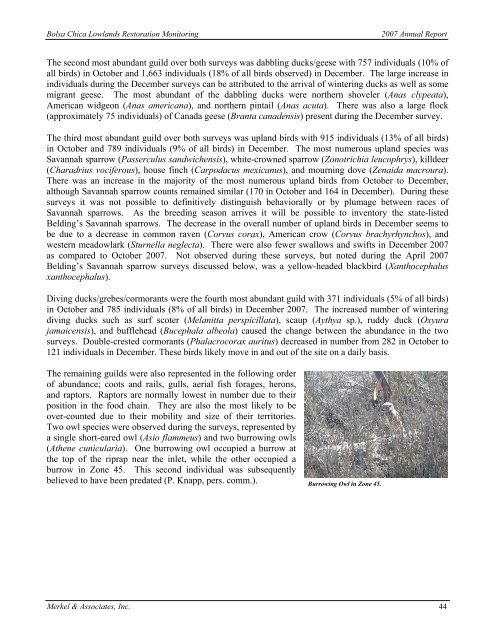2007 Annual Monitoring Report (pdf 16MB) - Bolsa Chica Lowlands ...
2007 Annual Monitoring Report (pdf 16MB) - Bolsa Chica Lowlands ...
2007 Annual Monitoring Report (pdf 16MB) - Bolsa Chica Lowlands ...
- No tags were found...
Create successful ePaper yourself
Turn your PDF publications into a flip-book with our unique Google optimized e-Paper software.
<strong>Bolsa</strong> <strong>Chica</strong> <strong>Lowlands</strong> Restoration <strong>Monitoring</strong><strong>2007</strong> <strong>Annual</strong> <strong>Report</strong>The second most abundant guild over both surveys was dabbling ducks/geese with 757 individuals (10% ofall birds) in October and 1,663 individuals (18% of all birds observed) in December. The large increase inindividuals during the December surveys can be attributed to the arrival of wintering ducks as well as somemigrant geese. The most abundant of the dabbling ducks were northern shoveler (Anas clypeata),American widgeon (Anas americana), and northern pintail (Anas acuta). There was also a large flock(approximately 75 individuals) of Canada geese (Branta canadensis) present during the December survey.The third most abundant guild over both surveys was upland birds with 915 individuals (13% of all birds)in October and 789 individuals (9% of all birds) in December. The most numerous upland species wasSavannah sparrow (Passerculus sandwichensis), white-crowned sparrow (Zonotrichia leucophrys), killdeer(Charadrius vociferous), house finch (Carpodacus mexicanus), and mourning dove (Zenaida macroura).There was an increase in the majority of the most numerous upland birds from October to December,although Savannah sparrow counts remained similar (170 in October and 164 in December). During thesesurveys it was not possible to definitively distinguish behaviorally or by plumage between races ofSavannah sparrows. As the breeding season arrives it will be possible to inventory the state-listedBelding’s Savannah sparrows. The decrease in the overall number of upland birds in December seems tobe due to a decrease in common raven (Corvus corax), American crow (Corvus brachyrhynchos), andwestern meadowlark (Sturnella neglecta). There were also fewer swallows and swifts in December <strong>2007</strong>as compared to October <strong>2007</strong>. Not observed during these surveys, but noted during the April <strong>2007</strong>Belding’s Savannah sparrow surveys discussed below, was a yellow-headed blackbird (Xanthocephalusxanthocephalus).Diving ducks/grebes/cormorants were the fourth most abundant guild with 371 individuals (5% of all birds)in October and 785 individuals (8% of all birds) in December <strong>2007</strong>. The increased number of winteringdiving ducks such as surf scoter (Melanitta perspicillata), scaup (Aythya sp.), ruddy duck (Oxyurajamaicensis), and bufflehead (Bucephala albeola) caused the change between the abundance in the twosurveys. Double-crested cormorants (Phalacrocorax auritus) decreased in number from 282 in October to121 individuals in December. These birds likely move in and out of the site on a daily basis.The remaining guilds were also represented in the following orderof abundance; coots and rails, gulls, aerial fish forages, herons,and raptors. Raptors are normally lowest in number due to theirposition in the food chain. They are also the most likely to beover-counted due to their mobility and size of their territories.Two owl species were observed during the surveys, represented bya single short-eared owl (Asio flammeus) and two burrowing owls(Athene cunicularia). One burrowing owl occupied a burrow atthe top of the riprap near the inlet, while the other occupied aburrow in Zone 45. This second individual was subsequentlybelieved to have been predated (P. Knapp, pers. comm.).Burrowing Owl in Zone 45.Merkel & Associates, Inc. 44






